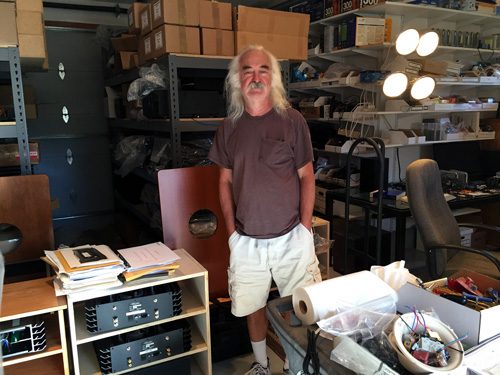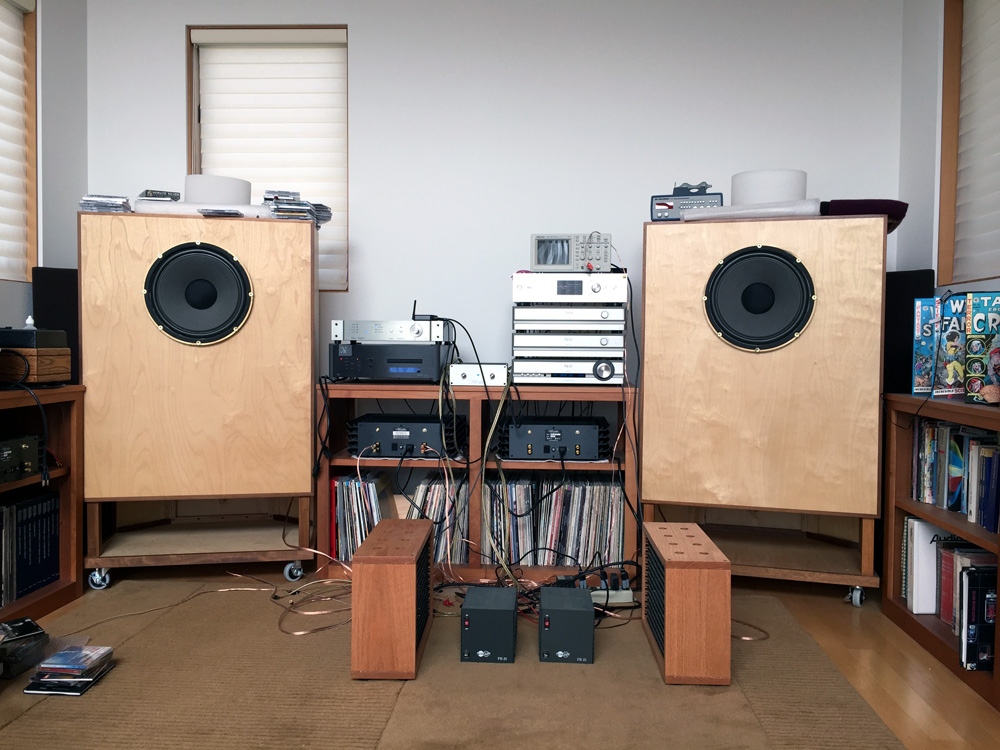In late September of 2015, I visited Nelson Pass at his Sea Ranch residence and he was busy designing new prototypes. Nelson is exploring new directions in circuit topologies continuously, for both Pass Labs and his hobbyist company, First Watt, which he founded in 1998. When asked First Watt’s purpose of being, Nelson answered that First Watt builds those products which are less mainstream and more personal to him. To me, while First Watt amplifiers are less powerful, they are more exotic and of a different kind of fun.
Take the First Watt SIT amplifiers, for example. Each monoblock of the $10,000 pair of SIT-1 is a 10-watt-per-channel design incorporating one single gain stage in the form of the Static Induction Transistor. This SIT device produces higher gain and lower distortion than other transistors, with such speaker-friendly operating voltages and currents that the output transformer is no longer needed. One gaine stage means higher fidelity, thus a truer sound to the source that is purer than that from other amplifiers. This device was custom manufactured by SemiSouth to Nelson’s specifications to behave like a triode tube. That’s right, Nelson possesses the only inventory of these SITs in existence. I count myself as one of the more fortunate ones for having both the SIT-1 monoblocks and the SIT-2. To me, the SIT amplifiers are the embodiment of excitement and exoticness.
Nelson, of course, loves all his creations and is of the opinion that all his products, Pass Labs and First Watts, are no less exotic. Take the Beast Of A Thousand JFETs, a design originally created for the Burning Amp Festival, and an obvious homage to film director Roger Corman, for instance. During my visit, he took the 20-watt monoblocks from dust-gathering duty into active use. We listened to the Beast via his open-baffle Lowther PM6A speakers, alternating with the Pass Labs-custom Tannoy HPD coaxials. The experience was incredible. The level of fidelity was the most palpable I’ve encountered in the context of the system. When asked his motivation for creating this most impractical of designs, his modest bearing came through again and he conceded that a few engineers had also thought of the design and he was just the one willing to risk failure. Nelson revealed to me that The Beast actually has over 1,200 J-FETs per channel.
For the title of amplification of the most exotic kind, I would have a hard time choosing between the Beast, the SITs and the Xs Preamp. The company’s X0.2 preamplification system of 2008 delivered the most complete suite of audio parameters I had encountered in my system up to that point, and truly carried the badge as the company’s top preamplification design to full glory. Its successor, the XP-30, a current product, continued the 3-chassis circuit topology of the X0.2 and pushed the envelope further. Having used both for a considerable period of time, I moved onto the 2-chassis Xs Preamplifier ($38k).
Costing more than twice of the XP-30, the 2-large-chassis Xs Preamp was developed from the ground up to accompany the new Xs monoblock amplifiers. Each channel of the Xs Preamp is governed by its own power supply board of high performance electrolytics and custom polypropylene capacitors to provide a 100,000 µf capacity. The Xs Preamp is further equipped with newly available silicon carbide rectifiers that drop the noise floor even below that of the XP-30. Furthermore, an Xs-exclusive DC coupled ultra-symmetric gain path with auto, high-bias class A circuitry attained the astounding feat of an even quieter background than the XP-30. Reaping the benefits of all these technological breakthroughs, I have been enjoying the highest level yet of conveyance of information from my favorite music. The Xs Preamp is the most capable of preamplifiers I have experienced. To me, the Xs Preamp is the super preamplifier of our time, and a quintessential American classic.
But for $16,500, the three-chassis XP-30 is the actual reigning champion for what we have to pay. There is a universe of vastly more expensive preamplifiers out there that will not outperform the XP-30 for a long, long time. That is because Nelson has jewels on his hand, they are: Wayne Colburn, long time co-designer and Desmond Harrington, company president/chief industrial designer. Each of them is a formidable engineer in his respective fields, and each contribute in kind to the development of Pass Labs products. The Xs Preamp and XP-30, for instance, is the brainchild of Wayne Colburn.
Then, there is the D1 DAC, arguably the most exotic product ever to have come out of Nelson and his company. For one, the D1 is extinct; things don’t get more exotic than being in extinction. Last year, I succeeded in commandeering a D1 from the private collection of Desmond Harrington. It was then paced through sessions of comparisons to the Esoteric K-03/G-01, the Pacific Microsonics Model One and a few highly regarded DACs. Even in the context of today, the Pass Labs D1, a year-2,000 design using four of then highly-regarded Burr Brown PCM-63 (K) in balanced configuration, produced a slightly less detailed soundstage than the Esoteric system, and yet remained imminently warm and resolving, musical, atmospheric, pure-sounding and thus continued to be among the best even in today’s standard! How can this be? Which design aspect of the D1 catapulted it to such heights, so ahead of its time? A thrice-grilled Desmond relented and said, “Because it’s created by analog guys.” Pass Labs’ definitive statement in DAC technology, one that is incorporated with a Pass Labs I/V amplification stage albeit its pre-Millennial vintage, is the D1 not exotic?
The other thing I like about the D1 is what is written in the Owner’s Manual, “The D1 is the work of Wayne Colburn, with some analog assistance by Nelson Pass. Feel free to contact either of us with questions or comments.” Giving credit where it is due, and making customers happy. Not bad at all.
But today’s Pass Labs is all about amplifications, and if there is to be a Pass Labs amplifier to be recognized for its utmost excellence, then it has to be the new XA200.8 monoblocks. Part II of this article will be a review of a pair of the amplifier.
Read Part II, Pass Labs XA200.8 Pure Class A High Current monoblocks Review
Copy Editor: Laurence A. Borden
- (Page 1 of 1)





I find it very interesting to see that the “legend” is using “standard” cables in his setup. No heavily overpriced hokus-pokus cables.
Nelson is one of the kindest guys in USA. He wants me to visit him at his Sea Ranch,but since I have this fantastic life both in Marbella and Norway,I am too lazy to be tormented for 12 hours in an Aeroplane. I lived in his house in Sacramento and had a fantastic time there.This was the Threshold , Stasis era. Anyway I miss him so much .
brilliant snapshots of nelson’s personal spaces, this article was so enjoyable!